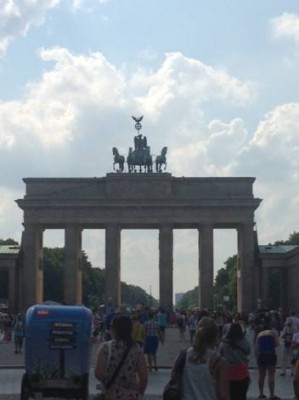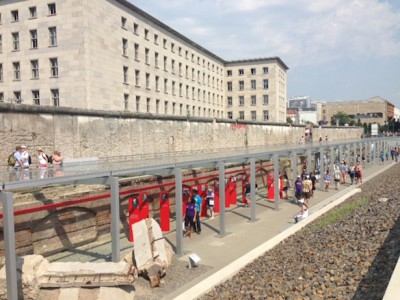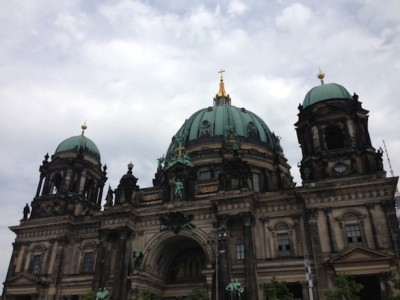BERLIN, GERMANY. Getting out of the taxi and meeting the heat of the city in Berlin, I could feel the rich history of a city that is a cultural and travel epicenter. I came to Berlin to study the Holocaust and did mainly that, while friends traveling with me took in the shopping and nightlife. I was able to view one side of the city, so I can only offer my experiences studying its history and vast connections to World War II.

Gardens of the Pergamon Museum | Alessandra Jacobs
I visited the Berliner Dom first, as it was the most centrally-located spot on my must-see list. The Dom, at am Lustgarten, is a massive cathedral with murals covering the towering ceilings. If in Berlin, you cannot miss this city landmark that costs just 4 Euros for students. On the lawns outside, you can get an even better look at the enormous building with its green domes and intricate detailing. It is a common wedding locale, so you may even get to observe stunning wedding photos being taken.
Pergamon Museum, at Bodestrasse, is a great place to see some wonderful pieces of history up close and personal, but the wait time can be extensive. Combined with an all-day pass that costs 17 Euros for the all the museums on “Museuminsel,” a better option might be to just see the museum gardens. The entrance gardens of the Pergamon Museum provide the same Roman feel of the museum but without all the hassle. Columns placed throughout the gardens and the beautiful landscaping really make it a sight to see. The gardens are centralized around a set of dual staircases that lead up to an elaborate building maintaining the Roman theme. The gardens of the Pergamon Museum are a great place to relax and take in the historical sights while also a having a perfect photo opportunity free of charge.

The classic destination in Berlin, the Brandenburger Tor | Alessandra Jacobs
Naturally when going to Berlin, an important stop for any visitor is the Brandenburger Tor, the classic gate at Pariser Platz in many a postcard from Germany’s capital city. It is a wonderful place to snap some touristy shots while also seeing an important piece of Berlin’s history. The gate has stood through and witnessed many wars. It is most notable for its place during the fall of the Berlin Wall. The gate is an essential part of the Berlin experience, too classic to miss.
Another historical glimpse of the Berlin Wall lies on Bernauerstrasse, where you can see an extensive exhibit showcasing the actual location of the Berlin Wall between two sides of one street. Metal poles show exactly where the wall used to stand, and an outdoor exhibit shows just how difficult life was during the separation of East and West Germany. There are many photos of the wall with watchtowers, vicious dogs, barbed wire, and booby traps. If you visit this memorial you will garner an entirely new perspective on the Cold War and its effects.
The Topography of Terror details the inner workings of Berlin during its darkest times. The outdoor and indoor exhibit takes a look at the remains of what were the SS and Gestapo headquarters during World War II. Later, it also became a of a part of the Berlin Wall.

A view from afar of the Topography of Terror Exhibit | Alessandra Jacobs
Distinct historical layers of oppression are in clear view. First, the oppression of those under the Nazi regime can be seen in what remains of the SS buildings. The more recent oppression of those living in East Germany is brought to life through the beaten-down memorial to the Berlin Wall. A most effective way to learn of Berlin’s history is to visit this museum on Niederkirchnerstrasse.
The memorial I was most interested in seeing up close was the Memorial to the Murdered Jews of Europe. This museum, located on Cora-Berlinerstrasse, is underground, but above is a memorial that is often said to be very subjective. The free-of-charge museum is beautiful, with an exhibit dedicated to letters written during the war.

The Memorial to the Murdered Jews of Europe at midday | Alessandra Jacobs
The memorial dedicated to victims of the Holocaust is something you must see in person. Its concrete slabs of varying heights are spaced out so that when you walk between then you feel like you’re in a corn maze. Standing and looking up at the memorial, seeing only concrete, made me think that this is what victims of the Holocaust might have seen: a sea of grey, with no clear way to escape their reality. Yet others saw a less grey future; they saw hope. You have to go there to form your own opinion of what such an ambiguous memorial could mean.
Berlin is the city to go to if you are studying the Second World War. It is a city that is incredibly rich in history and to visit these locales is a way to experience that vast history with a limited amount of travel time. Berlin is a city of duality: a place filled with museums, culture, and memorials, but still a happening city filled with life and any and all activities you desire.

